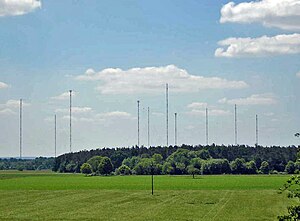DCF77
| DCF77 time code transmitter | |
|---|---|

The low frequency T-aerial antennas of DCF77 in Mainflingen
|
|
| Location | Mainflingen longwave transmitter, Mainflingen, Germany |
| Coordinates | 50°00′56″N 9°00′39″E / 50.01556°N 9.01083°ECoordinates: 50°00′56″N 9°00′39″E / 50.01556°N 9.01083°E |
| Elevation | 113 m (371 ft) |
| Operator | Media Broadcast GmbH of behalf of the PTB |
| Frequency | 77.5 kHz |
| Power | 50 kW |
| Began operation | 1 January 1959; continuous date and time information was added in June 1973 |
| Official range | 2,000 km (1,243 mi) |
| Website | DCF 77 |
DCF77 is a German longwave time signal and standard-frequency radio station. It started service as a standard-frequency station on 1 January 1959. In June 1973 date and time information was added. Its primary and backup transmitter are located at 50°0′56″N 9°00′39″E / 50.01556°N 9.01083°E in Mainflingen, about 25 km south-east of Frankfurt am Main, Germany. The transmitter generates a nominal power of 50 kW, of which about 30 to 35 kW can be radiated via a T-antenna.
DCF77 is controlled by the Physikalisch-Technische Bundesanstalt (PTB), Germany's national physics laboratory and transmits in continuous operation (24 hours). It is operated by Media Broadcast GmbH (previously a subsidiary of Deutsche Telekom AG), on behalf of the PTB. With Media Broadcast GmbH, a temporal transmission availability of at least 99.7% per year or under 26.28 hours of annual downtime has been agreed upon. Most service interruptions are short-term disconnections of under two minutes. Longer lasting transmission service interruptions are generally caused by strong winds, freezing rain or snow induced T-antenna movement. This manifests itself in electrical detuning of the antenna resonance circuit and hence a measurable phase modulation of the received signal. When the maladjustment is too large, the transmitter is taken temporarily out of service. In the year 2002 almost 99.95% availability or just over 4.38 hours of downtime was realized. The timestamp sent is either in Coordinated Universal Time (UTC)+1 or UTC+2 depending on daylight saving time.
...
Wikipedia
